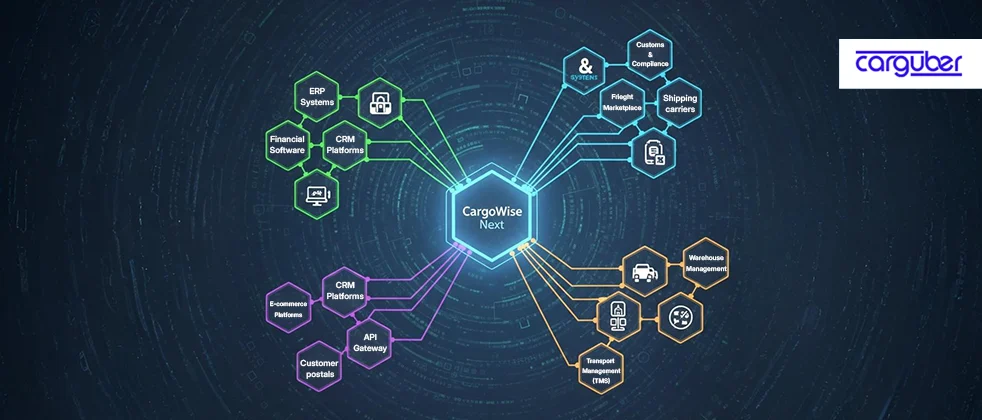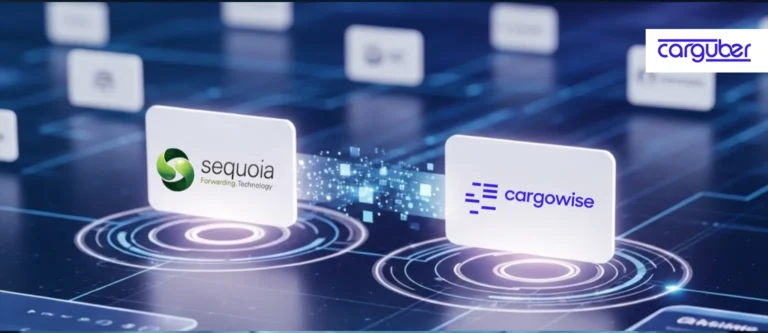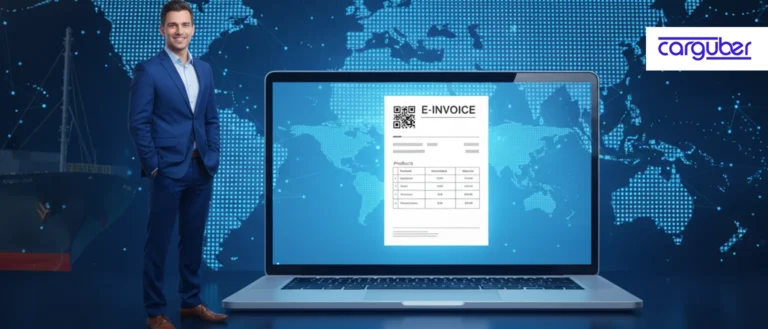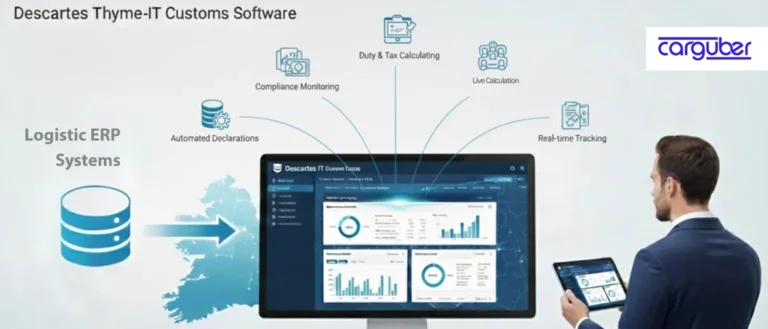What Types of Logistics Systems Can You Integrate with CargoWise Next?
Success in logistics goes beyond quick execution; it’s about creating a fully connected ecosystem. A freight forwarder may have the best processes, but if data between their financial, warehouse, and transportation systems does not sync, inefficiency sets in. This is where CargoWise Next stands out. Built to unify complex logistics operations, its true potential is realized when it integrates seamlessly with other systems on which your company relies.
Many logistics companies now use multiple platforms, including an ERP for finance, a CRM for customer management, a WMS for warehousing, and third-party systems for customs, carriers, and analytics. When these systems work in silos, teams spend more time reconciling rather than optimizing. Carguber helps to break down those barriers by creating integrations that make CargoWise Next your unified source of truth across all departments.
Strategic Benefits of CargoWise’s Next Integration
Without integration, operations and finance can feel like two separate worlds. Data entry duplication, missing shipment details, and inconsistent billing are all common issues that cause reporting delays and lower profitability.
When CargoWise Next is integrated into your larger digital ecosystem, everything changes. You will gain:
- Real-time visibility for shipments, invoices, and customer updates.
- Automated financial postings allow for 40% faster billing.
- Manual updates are reduced by 50% across all systems.
- Unified reporting and analytics enable three times faster decision-making.
These measurable results demonstrate that integration is more than a technical improvement; it is a strategic enabler that allows logistics teams to focus on service excellence rather than system management.
Key Logistics Systems You Can Integrate With CargoWise Next
1. Financial & ERP Systems
To ensure profitability, finance and operations must work together. Integrating CargoWise Next with SAP or accounting systems such as Oracle, NetSuite, Xero, or QuickBooks reduces the need for duplicate data entry and ensures financial accuracy. With this integration, invoices generated in CargoWise are automatically posted to your ERP, payments are reconciled immediately, and ledger balances are updated in real time.
As a result, your finance team has complete visibility into revenue and costs, while operations teams can track profitability by shipment rather than waiting for monthly reports.
Advantages include:
- Real-time synchronization of invoices, accruals, and payments.
- Elimination of manual journal entries.
- Accurate reporting for audit and compliance.
Forwarders can strengthen their financial backbone and promote transparency by integrating CargoWise with ERP platforms.
2. CRM Platforms
Your sales and customer service teams use CRM systems like Salesforce, HubSpot, and Zoho. Meanwhile, your operations team is using CargoWise. The challenge? Both handle customer data in different contexts, resulting in fragmented communication and delayed follow-ups.
Integrating CargoWise Next with your CRM ensures that all quotes, leads, and customer interactions are consistent across departments. When a new customer record or quotation is created in the CRM, it is automatically imported into CargoWise and available for job creation or documentation.
Key benefits:
- Eliminate duplicate customer data entry.
- Maintain consistent visibility into customer history and job status.
- Improve customer response times with accurate operational data.
A connected CRM and CargoWise environment provides a 360° view of each customer, improving service quality and retention.
3. Port and Customs Systems
Customs compliance is critical to the international freight forwarding industry. Integrating CargoWise Next with ASYCUDA, ICEGATE, CBP ACE, or local customs EDI portals automates declarations, document submissions, and data validation, resulting in faster, more error-free customs processing.
CargoWise allows you to transmit HS codes, invoice numbers, and declaration data directly to customs authorities rather than manually entering them. When approvals are received, they are automatically entered into your job file.
Benefits include:
- Faster clearance and fewer human errors.
- Automatic exchange of import and export declarations.
- Increased visibility of compliance documentation.
This integration ensures that your operations team can process more shipments without increasing administrative workload while maintaining complete regulatory compliance.
4. Warehouse Management System (WMS)
Warehouse data is frequently dynamic, with inventory levels changing hourly, and delays in synchronization can result in shipment planning errors. Integrating CargoWise Next with your warehouse management system results in a continuous feedback loop between physical inventory and digital operations.
When a pallet is received, scanned, or dispatched in the warehouse, CargoWise receives an instant notification. Job files, shipment manifests, and delivery notes are automatically generated.
Advantages:
- Real-time visibility into stock movement.
- Error-free communication between the warehouse and operations teams.
- Manual data handling in the warehouse has been reduced.
This integration improves operational control, allowing logistics providers to manage space and speed more efficiently.
5. Transportation and Carrier Platforms
Your transportation data, from pickup to proof of delivery, reveals the true story of logistics performance. Integrating CargoWise Next with carrier systems such as Maersk, FedEx, DHL, or airline portals ensures that milestone updates, tracking data, and POD confirmations are automatically delivered.
This eliminates the need to continually check multiple carrier websites for status updates. Instead, CargoWise receives live event data, which your teams and customers can access through a single interface.
Key outcomes:
- Status updates and notifications are automated.
- Transportation documentation can be processed more quickly.
- Improved visibility across multimodal shipments.
For logistics companies, this integration not only saves time but also improves transparency throughout their global network.
6. Vendor and Procurement Platforms
Procurement frequently requires managing multiple suppliers, purchase orders, and cost approvals. Connecting CargoWise Next with procurement systems or vendor portals allows you to standardize the flow of financial and operational data.
For example, when a vendor enters an invoice into the procurement system, it is automatically validated and recorded in CargoWise. This results in a single, traceable audit trail from supplier to shipment.
Benefits:
- Faster cost approvals and payment cycles.
- Reduced discrepancies between vendor bills and job files.
- Improved spending visibility and forecasting.
With vendor integrations, freight forwarders get closer to full financial automation, which reduces errors and disputes throughout the supply chain.
7. Collaboration & Messaging Tools
CargoWise integration with collaboration tools like Microsoft Teams, Slack, or WhatsApp gives you end-to-end supply chain visibility as well as the ability to share job updates, document approvals, and shipment alerts within your organization.
For example, when a customs entry is cleared or an invoice is posted, team members can be notified using their preferred communication tool. This allows operations to run smoothly without requiring frequent email follow-ups.
Practical advantages:
- Instant communication linked to live job data.
- Faster approvals and decision-making.
- Improved cross-team coordination in hybrid work setups.
It’s a small change that has a significant impact on everyday logistics communication.
8. Business Intelligence & Reporting Tools
Every logistics decision relies on data, but raw data isn’t insight until it’s visualized. Connecting CargoWise Next with the BI Dashboard solution converts operational metrics into actionable insights.
Finance teams can analyze margin per job, operations can track shipment turnaround times, and management can monitor branch performance in real time.
Benefits of integration:
- BI dashboards that combine revenue, cost, and customer data.
- Real-time visibility into key performance indicators across regions.
- Data-driven forecasting enables more effective planning.
With BI integration, decision-making shifts from reactive to proactive, providing leaders with visibility to drive growth.
How Does Carguber Enable Seamless CargoWise Integrations?
Building these integrations requires expertise, precision, and a thorough understanding of both logistics and technology. Carguber specializes in complete CargoWise implementation, customization, and configuration with external systems using APIs, EDI, and middleware frameworks like eAdopter to ensure data consistency, compliance, and scalability.
Our structured integration process involves:
- Requirement Analysis: Assessing your system architecture and integration goals.
- Data Mapping: Aligning CargoWise fields with the corresponding fields in other systems.
- Configuration & Testing: Setting up secure APIs and verifying end-to-end data flow.
- Go-Live & Monitoring: Continuous performance checks, maintenance, and optimization.
This structured approach ensures that your systems communicate flawlessly, lowering IT overhead while increasing accuracy and speed across workflows.
Conclusion
The success of your logistics systems is determined by how well they communicate with one another. CargoWise Next already provides unparalleled functionality for your freight operations, but when combined with ERPs, CRMs, WMS, and analytics tools, it becomes a fully integrated logistics ecosystem.
If you want to automate, optimize, and scale with confidence, integrating CargoWise Next is the next strategic step. Carguber handles that transformation, allowing your company to operate faster, smarter, and with complete visibility across all processes. Contact us today!









